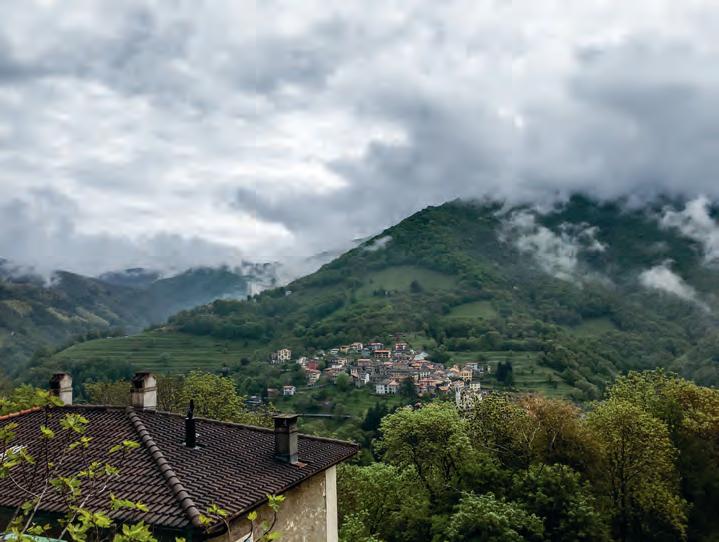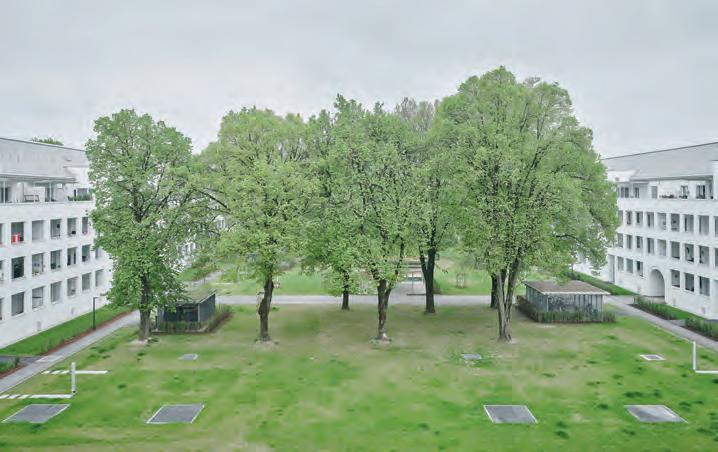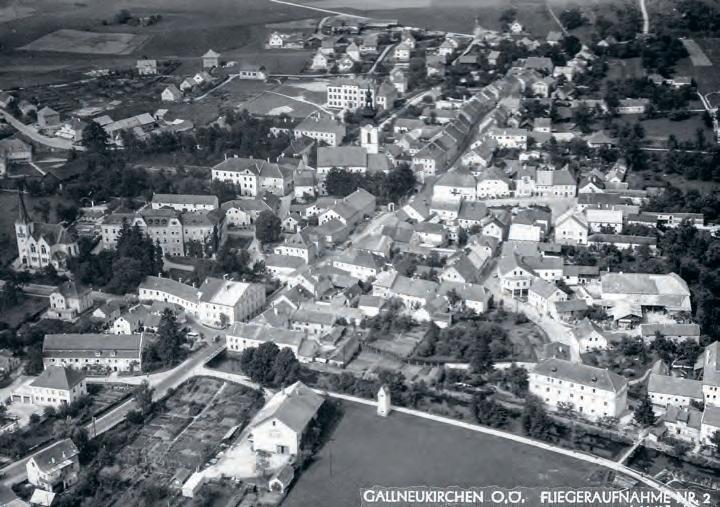

Albert Kirchengast
Continued Building on the Village, the Settlement, the City A Plea
Birkhäuser Basel
“Isn’t everything like it never was?” B otho Strauß
Resistance
The short text entitled “Resistance” accompanies a monograph that was published in 2002, when the work of Jonathan Sergison and Stephen Bates already enjoyed international attention. The manifesto of the two architects is found at the end of the magazine, illustrated by just two images: of Joseph Beuys’s legendary felt suit and of an anonymous brick wall set in an English landscape. The latter image appears so dusky on the paper that the mood is strangely enchanting – as if night is already falling. The grayish tone and the rawness evoke the aura of the timelessly old, unplastered wall, built of gently weathered stones laid in simple courses. We peer, with the two architects, into a corner, where the wall with its beautiful coping changes direction. Our thoughts drift to this place; we feel as if we have been transported to an archaic quadrangle. Animated, towering broad-leafed trees surround the enclosing wall, which restrains the greenery by setting a boundary. The walled space is dominated by a tidily mowed lawn. This is a primeval scene, a hortus conclusus, a concrete symbol, and an archaic spatial element, the limitation of the human domain through the act of joining together small bricks to form a wall. Somewhere in the distance, out of shot, stands the house.
SERGISON - MONTE
The House of the Architect
Every opportunity is an offer. Thus begins Jonathan Sergison’s account of his fascination for a house in Monte, a mountain village high above Mendrisio in the canton of Ticino. It first caught his eye when he started teaching at the Università della Svizzera italiana. Four years after buying the house in 2010, the approximately 350-year-old structure has become his family home – in summer everyone is here. Sergison speaks of domesticity as the theme of his design interventions. These begin with the retention of the house, not by preserving every trace as building conservation – the act of conserving and protecting historic buildings and other monuments –may demand, because the house is a listed building. But this is not the basis of his meticulous approach. Rather, he was convinced from the very beginning by the presence of history in the form of the spaces and structure of this piece of the jigsaw of the village’s built fabric. One could say: It is about the resonance of the inconspicuous. In order to retain this quality, the avowed metropolitan had to find the right use for these spaces, in the heart of a mountain landscape that remains, to this day, as tough as it is idyllic. This landscape sets the tone, defines the way of life, as long as one engages with it. Everything had to remain and, yet, had to change so that the domesticity ingrained in the house by earlier inhabitants could also remain, by becoming a domesticity that corresponds with his family and himself.
When Jonathan speaks of his house, he begins with the views that are possible here, into the spaces, into the streets. Then – when one
steps out of the house into this distinctive network of public spaces that permeate the cluster of similar houses in the clearing on the steep mountainside – there is the view of the distant forests on the opposite side of Val di Muggio. Thinly spread and surrounded by forest, the few villages resemble pearls, strung out along the necklace of a narrow and, for the inexperienced, rather dangerous road; the people up here seek to obtain their provisions through exchange, each village offers something. One becomes aware of this after completing the steep climb up into this seemingly isolated world. As it traces its circular route between the villages, this road becomes a communicating vessel, the supply artery of the people of this enticing corner of the Southern Alps, who have no desire to return back down into the valley. The “House in Monte,” as it is referred to by the architect from afar who was brought here by his work, is an example of the all-embracing interconnectedness of the local that is possible today. This does not have to involve destruction: It is possible to not just retain such buildings, such places, but also enhance them so that they belong to the present. We are reminded of this by the exotic plants – the palms, citrus trees, camellia, oleander – that have been introduced into the landscape around Ticino’s lakes over the course of the past few centuries. They bear witness to the fact that change also brings opportunity – in this sublime mixed climate with the light that suddenly hits you as you enter the Southern Alps. It will not be long before the landscape levels out and heads for the sea.
The house first had to be stabilized structurally, it had been neglected. Following building measures that were as decisive as they were essential, it now appears to have been inserted into its rocky

surroundings – its raw plaster surfaces interacting with its neighbors. But it does not feel set apart, because one senses that this is a building that was already here. We get the strange feeling that we are looking at a doppelganger. Anyone comparing the images of the near ruin of the original building with Hélène Binet’s photographs notes the skill with which the former timber outhouse has become today’s loggia and sees how it provided the inspiration that has led to something new. But it does not force itself upon us –it does not declare: “I am the work of an architect!” The walled forecourt reinforces the spatial qualities of the old in-between space, holding off the tightly woven urban space of the village and establishing the privacy that we seek today. All the essential elements are based on current needs, but these are subordinate to the permanence of the house and when we find them they almost seem like new “opportunities” that are waiting to be discovered. Such a house, which is inherently rich in quality and has developed slowly as it has passed from hand to hand, offers much to the present: The parlor remains the parlor, because the hearth, the physical manifestation of the open fire, was and remains an essential element. Facing the street, it can also serve today as a study or a formal dining room; here is the newly inserted library. The kitchen is practical, but modestly equipped, and its fittings do not compete with the open fire. This room is a focal point in the labyrinthine layout, a stair climbs from here to the next floor. Thus, the present has been anchored in the historical use of the house, whose spatial implicitness reflects rural daily life, because it is still a place of ritual. And even if the house’s earlier role, to accommodate the equipment that enabled farmers to remain self-sufficient, was
Living Contexts
“The construction of the barns was a sort of moment of renewal in the building of a village, because they kept getting larger and higher. […] We had two groups of carpenters: The work of one group became more and more pleasing while that of the other became increasingly coarse. I asked myself why this was happening – why, in one case, the structures were becoming more ‘graceful’ and ‘appealing.’ Of course these are the wrong words, for the truth is that one was simply delighted that their work was so beautiful. But why didn’t the other group manage this?” 15 Questions such as “how is it done?” and “why is the form appealing?” resonate in the memory of the architect – not to forget the delight in experiencing the achievement that echoes in these words. Franz Riepl’s meditations about his own introduction to village life touch upon a moment of initiation that occurred when he was still a child. The architect was born. Riepl, who has been a self-employed architect in Munich since 1967 and was Professor of Agricultural Building and Rural Settlement at Graz University of Technology until 2000, remains faithful to these early experiences of the rural area in which he was born in the north of Upper Austria. This is where he first experienced the act of construction in the form of the erection of simple timber structures,



Urban quarter “One” and center of Gallneukirchen, location plan
Designing the Context
Is it not the duty of those who conserve historical monuments to accept – and to assume responsibility for the Continued Building of –the existing? Is it not they who have the best access to the relevant knowhow? The two buildings discussed above would have corresponded perfectly with a pre-modern understanding of historical conservation – before a modern approach to history drove a division between “monuments” and the rest of the built world and turned them into historical witnesses that act as material messengers of the past. But this is just one side. Because there is a good reason for “conserving” buildings of general interest, for “integrally” retaining them, with all their material traces. Their “authenticity” transforms them into built documents, spaces from the past in the present, differentiates them from chimeras. Then, in a special way, monuments are places where we experience a historical living environment. But even amongst those few buildings that can truly be considered as first-class monuments, complete preservation is, for obvious reasons, not possible. Life has changed and time does not stand still. Hence, the long-matured vocabulary, the practical knowledge of building conservation, is important for Continued Building, which is also historical conservation today – because it involves precisely
Urban Presence
As well as being a forward-looking design-based activity that diligently works over generations, urban planning is about a community, whose place of political exchange is the city. Furthermore, a society only emerges from the dense clarity of heterogeneous ideas – which find their common purpose in the shared urban realm. In contrast with other notions of the city, Jan Pieper has pointed out that one specific feature of the European city is the way it understands the urban square as a “spatial platform,” whose form seeks “to reflect the structure of society by embodying the widely different nuances of the representative and participatory public realm.” 32 In contrast with this, it may appear convoluted and dry when separations, alignments, building lines, the number of floors, building type, facade design, greenery, and even rules governing the use of materials, all defined in word and number, serve as the sober origin of this phenomenon. Such requirements or objective design instruments are nothing other than the equivalents of the spatial sensitivity that is at work in the house as a small city and the city as a large house, or ways of formalizing our experiences that are already embedded in the cultural form of the city. They are attempts to objectify our spatial understanding – whether this is latent or based on our conscious experience of urban elements such as the street, square, courtyard, etc., in which actions, encounters … and yes, again, uses are inscribed. And even if this often appears forgotten in practice, it does not need to be addressed again here for it has long been the subject of relevant treatises such as Camillo Sitte’s Der Städtebau nach seinen künstlerischen Grundsätzen from 1889.

Generations later, in his Scientific Autobiography, Aldo Rossi is more direct: “Each place is remembered to the extent that it becomes a place of affection, or that we identify with it.” 33 Feeling and knowing, presence and memory are strangely interwoven in this somewhat enigmatic statement. If one follows Rossi conceptually, this can only mean that the experience of the now and the memory are siblings. That history is dependent upon current experience and that the city as a cultural achievement is always realized in the here and now and only exists as a continuation of the past and the present. “The project itself became a rediscovered object,” 34 is his conclusion for design in general. Design is a process of “discovering” things in a shared space with a history, not of “churning things out.” Above, we called it hervorbringen “bringing forth.” And the city is now its platform, its place. Max Dudler’s work belongs to the same tradition, which recognizes the body of the architecture as the basic bearer of experiences – in the urban space that appears to ascribe value through interaction. He has devoted himself to the resilience of the city made of stone, to its Continued Building; mostly in stone and sometimes in brick or even glass. In conversation, he expresses his basic principle as: “Thinking of the future, we place ourselves in a continuity.” 35 This requires the space of the polis as a place of exchange, in which we can search for context. And he continues: “Only rarely do we show consideration for what has grown, only rarely does modern building establish relationships between things in the wider sense. Creating a new, coherent urban structure within the segmented fabric of the city is a unique urban planning challenge.” Wherever Max Dudler and his office successfully apply Continued Building to complex urban situations, he is naturally



at the other end of the district and lives an urban life, while enjoying the views of the surrounding hills. One shops as if one is in a shopping center, but one is not. And, above all, the new built fabric plugs into the old town, but equally presents itself as a new district. The “supermarket problem” – the constant desire of the public to be able to choose from lots of products at once – has also been solved, for this is hidden in the heart of the ensemble, albeit not underground. Thanks to the height of the space, which is a sort of gallery, the light comes from outside and above. The entrance to the gallery doubles as the main portal to the new quarter, which is also right next to the historic head of the bridge; two open stone stairs convey pedestrians to the new open spaces. Incidentally, this is another reason why this is a piece of city, because rights of way have been preserved and the apartments have many different owners. Thirty apartments with between 54 and 135 square meters are laid out to meet a wide range of needs; they have a total area of 2,500 square meters, with 3,800 being occupied by shops and restaurants and around 3,000 by office space.
The solution that led to Max Dudler’s success against the impressive list of competitors – the result of his expert, urban planner’s interpretation of the plot ratios and spatial program – consists of density and mix, a combination of a range of activities in one building, and an approach in which the volumes are only ostensibly an erratic fabric of stand-alone structures based on a system of urban building lines, boundaries, and routes, etc. For this fabric is derived from the existing and it is this that lends it its form, which is then refined, physically and spatially improved – addressed as a network of in-between spaces – in a series of revision phases. As a result, the new
DUDLER - GALLNEUKIRCHEN




Author
Albert Kirchengast, A-Vienna
Acquisitions Editor
David Marold, Birkhäuser Verlag, A-Vienna
Content & Production Editor
Bettina R. Algieri, Birkhäuser Verlag, A-Vienna
Translation German / English
Rupert Hebblethwaite, A-Vienna
Layout, cover design, typography
Albert Kirchengast, A-Vienna
Adaptation of plans
Juan Carlos Gómez and Florian Schuchlenz, A-Graz
Image editing Pixelstorm, A-Vienna
Printing
Holzhausen, the book-printing brand of Gerin Druck GmbH
This book is the fourth volume in the series Baukulturaria from the Verein zur Erhaltung und Erforschung der österreichischen Baukultur.
Series Editors
Hans Kolb, A-Graz, and Albert Kirchengast, A-Vienna
Library of Congress Control Number: 2022948606
Bibliographic information published by the German National Library
The German National Library lists this publication in the Deutsche Nationalbibliografie; detailed bibliographic data are available on the Internet at http://dnb.dnb.de.
This work is subject to copyright. All rights are reserved, whether the whole or part of the material is concerned, specifically the rights of translation, reprinting, re-use of illustrations, recitation, broadcasting, reproduction on microfilms or in other ways, and storage in databases. For any kind of use, permission of the copyright owner must be obtained.
ISBN 978-3-0356-2650-6
e-ISBN (PDF) 978-3-0356-2651-3
German Print ISBN 978-3-0356-2649-0
© 2023 Birkhäuser Verlag GmbH, Basel P. O. Box 44, 4009 Basel, Switzerland
Part of Walter de Gruyter GmbH, Berlin / Boston
